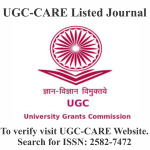EXAMINING THE RELATIONSHIP BETWEEN FARM INVESTMENT SUPPORT AND AGRICULTURAL AREA, PRODUCTION AND PRODUCTIVITY IN TELANGANA, INDIA
DOI:
https://doi.org/10.29121/shodhkosh.v5.i6.2024.6485Keywords:
Farm, Agricultural, Production and Productivity, TelanganaAbstract [English]
This research investigates the correlation between farm investment assistance provided by Rythu Bandhu and essential agricultural performance metrics, specifically the area cultivated, production levels, productivity, and agriculture's economic contribution to the state. The analysis utilizes secondary data obtained from the Directorate of Economics and Statistics, Government of Telangana, the Ministry of Agriculture, and the Socio-Economic Outlook of Telangana, encompassing the period from 2018–19 to 2023–24.
The study utilizes descriptive statistics and Karl Pearson’s correlation analysis to examine the strength and direction of associations among variables such as the number of scheme beneficiaries, total farm investment under Rythu Bandhu, total area covered, and economic indicators, including the contribution of agriculture to GSDP and per capita income. The results show a strong and statistically significant positive relationship between the number of beneficiaries and both the total financial support (r = 0.938, p = 0.006) and the area covered by the program (r = 0.885, p = 0.019). This means that more outreach and investment are closely linked. Additionally, the number of beneficiaries is significantly correlated with agriculture's contribution to GSDP (r = 0.817, p = 0.047), indicating a favorable macroeconomic effect of the scheme.
But the links between Rythu Bandhu variables and bigger indicators like the share of agriculture in Gross State Value Added (GSVA) and per capita income are not statistically significant, even though, they are positive. This shows that there may be a gap between growth in specific sectors and their relative contribution to the overall state economy. This could be because non-agricultural sectors are growing faster. In conclusion, the study offers empirical evidence that Rythu Bandhu has favorably impacted agricultural investment and economic output, especially regarding the enhancement of coverage and the augmentation of farm-level support. Its broader effects on structural economic indicators, on the other hand, are still limited. This suggests that we need to use integrated strategies that combine direct support with long-term infrastructure, extension, and market linkages.
References
Amitha, C. D., Karthikeyan, C., & Nirmala Devi, M. (2021). Assessing the Impact of Rythu Bandhu Scheme in Warangal District of Telangana. Asian Journal of Agricultural Extension, Economics & Sociology, 39(11), 335–340. DOI: https://doi.org/10.9734/ajaees/2021/v39i1130758
Basantaray, A. K., Acharya, S., & Patra, T. (2024). Crop diversification and income of agricultural households in India: An empirical analysis. Discover Agriculture. DOI: https://doi.org/10.1007/s44279-024-00019-0
Frontiers. (2023). Effects of agricultural subsidies on farm household decisions: A separable household model approach. Frontiers in Sustainable Food Systems. https://www.frontiersin.org/articles/10.3389/fsufs.2023.1295704/full
IJSE. (2022). Efficacy of public spending for agricultural development in India: A disaggregate analysis contextualizing subsidies vs investment debate. International Journal of Social Economics.
Kumar, M. B. (2022). Impact of Farm Subsidies on Gross Capital Formation (GCF) in Agriculture Sector of India. Indira Gandhi Krishi Vishwavidyalaya.
Mishra, N., Tiwari, A., Joshi, M. D., Gaurav, Kumar, D., & Misra, V. K. (2024). Assessing the Impact of Agricultural Subsidies on Farm Profitability and Sustainability. Journal of Experimental Agriculture International. DOI: https://doi.org/10.9734/jeai/2024/v46i82711
Padmavatahi, K. (2024). An Analysis of Rythu Bandhu Scheme in Telangana State. International Journal of Research and Scientific Innovation. DOI: https://doi.org/10.51244/IJRSI.2024.1109015
Sneha, V., Janaiah, A., Alibaba, M., & Chary, D. S. (2021). Perceptional Study of Beneficiaries and Non Beneficiaries Towards Rythu Bandhu Scheme in Telangana. Journal of Experimental Agriculture International, 43(9), 64–72. DOI: https://doi.org/10.9734/jeai/2022/v44i930845
Zafar, S., Aarif, M., & Tarique, M. (2023). Input subsidies, public investments and agricultural productivity in India. Future Business Journal, 9(1), 1–18. DOI: https://doi.org/10.1186/s43093-023-00232-1
Downloads
Published
How to Cite
Issue
Section
License
Copyright (c) 2024 S. Siva Prasad, K. Anji Reddy

This work is licensed under a Creative Commons Attribution 4.0 International License.
With the licence CC-BY, authors retain the copyright, allowing anyone to download, reuse, re-print, modify, distribute, and/or copy their contribution. The work must be properly attributed to its author.
It is not necessary to ask for further permission from the author or journal board.
This journal provides immediate open access to its content on the principle that making research freely available to the public supports a greater global exchange of knowledge.




















